



The Racquet Club Estates Neighborhood Organization is a member-driven organization made up of dedicated residents who are
passionate about one of Palm Spring's most historic, vibrant and authentic neighborhoods.

The mission of Racquet Club Estates Neighborhood Organization is to improve the quality of life in our neighborhood. As a team of neighbors we meet to discuss and act upon issues affecting our neighborhood; striving to improve the safety and appearance of our neighborhood and to enhance communications among neighbors and with the city.
To see whats happening in your neighborhood subscribe to our Facebook page and newsletter below to keep up to date

The Racquet Club Estates NORG (RCENO) is very proud to announce the installation of FOUR Little Free Libraries in our
neighborhood. Little Free Libraries (LFL) are hand-crafted structures filled with constantly changing collections of books
donated and shared by people of all ages and backgrounds.
RCENO joins the world with being a part 40,000 Little Free Library book exchanges around the world. They are represented in all
50 states and more than 70 countries. The RCENO LFL’s are located in front of the homes at 896 E. Racquet Club, 2275 N Starr,
589 E. Francis and 1115 E. Padua Way. For more information, please visit www.littlefreelibrary.org. In the meantime, share the
goodwill with our neighborhood; stroll by, stop by and “Take a book, Return a book” and enjoy!

RCENO holds monthly meetings each month in a different neighbours home.This is your opportunity to get involved and meet your neighbours. Sign up to our newsletter below for more information. You can find details of the upcoming meetings and also read the minutes from previous meetings here.
With nearly 550 single family residences, RCENO is quite possibly the largest of Palm Springs'
neighborhood organizations. Our organization area is roughly contained within the streets of San Rafael, Ave. Caballeros, Vista
Chino, and Indian Canyon Drive. The vast majority of residences in our unique neighborhood are attributed to very iconic and
respected area developers and architects.

Racquet Club Estates features homes designed by some of the leading Mid Century architects.
Designed by the respected architect William Krisel A.I.A., the Racquet Club Road Estates development was the largest
single-family tract home venture built by the famed Alexander Construction Company, and comprises the greatest area of
RCENO
The beauty of these post and beam homes designed in the mid-century modern vernacular is found in the soaring waferthin
rooflines, clerestory windows, an open floor plan, and a unique indoor-outdoor relationship. Enormous lot sizes contribute
greatly toward the livability and enjoyment of these homes.
We had the honor of meeting with William Krisel, the architect of the Racquet Club Road Estates, on September 9, 2006. We
spoke for two hours at his Brentwood home that he designed and built in 1955. It was easy to discern the distinctive Krisel
elements that influenced the Alexander houses a few years later: space-age kitchen cabinets, beamed tongue and groove
ceilings with clerestories, exterior wood screens, a courtyard between the open carport and house, and interesting
indoor/outdoor relationships.
In fact, Bill said that George and Robert Alexander requested elements from his house be included in their developments.
Bill was partnered with Dan Palmer then, but Palmer didn't work on the Palm Springs or San Diego developments; he
concentrated on other regions . The sudden death of the Alexanders and their wives in a plane crash on November 14, 1965
curtailed much of Bill's work including a renovation of the Palm Springs Racquet Club which the Alexanders owned at the
time. By the mid-1960's Bill stopped designing single family homes and concentrated on high-rises.
Bill was generous enough to allow us to include his original elevations on the website. They are displayed below along with the real estate agent's original flyer for the development.


There are notable omissions in the built houses compared to the original designs which Bill says was done to keep the
homes affordable. Overhangs were eliminated and clerestories in the rear elevation were deleted. Flat roofs lost all their
clerestories and gable models lost the floor to ceiling bedroom windows and full width gable glass. When renovating, these
original drawings should be helpful in keeping our houses stylistically accurate.
Bill is clearly peeved by alterations to the houses that aren't sensitive to the original design. These include randomly punched windows, filled-in courtyards, enclosed carports, and the interruption of indoor/outdoor components such as the entry fence projecting into the kitchen. Since there seem to be no color photos of the houses when new, we asked what the original colors were. He showed us the original color schedule that specified the paint for each element of each house which was varied throughout the development. Unfortunately, the color references are from the O'Brien paint company which no longer exists. One consistency was that the ceiling beams in each house were always painted Weathered Brown, just as they are in Bill's house today.
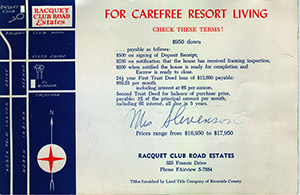
The Meiselman homes, located towards RCENO's southern boundary, is another sizeable block of historic mid-century
modern residences built using the post and beam technique, clerestory windows, tongue and groove ceilings, scored stucco
treatments, and walls of glass that contribute to indoor-outdoor enjoyment of amenities. Both Alexander and Meiselman hoped
to capture and capitalize on the growing second home market of the era, appealing to potential buyers interested in an
affordable vacation home. 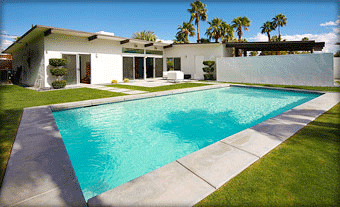
Similar to the Alexander Construction family, Jack and Bernie Meiselman built affordable mid-twentieth-century modern post
and beam homes in Palm Springs California during the years of 1959-1960. In fact, these homes are so similar to the popular
Alexander houses that Meiselman midcentury modern homes in Palm Springs that they are often compared to and sometimes
mistaken for Alexander homes.
Meiselman and Alexander mid-century modern homes share many similar architectural attributes. Characterized by crisp clean lines, butterfly roofs, and soaring clerestory windows - the Meiselmans used post and beam construction, with tongue and groove ceilings, and architecturally sculpted concrete block as shade blocks and as a design element.

Decorative concrete blocks provide both form and function, design and sun shade, for Palm Springs Alexanders and Meiselman
homes.
The Meiselman homes and the Alexander homes helped define the carefree and sunny indoor / outdoor modern
living lifestyle that Palm Springs is world famous for.
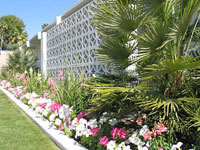
Meiselman houses feature large walls of glass that overlook the pool and the beautiful mountain backdrops
in Palm Springs. Most Meiselman homes also included central heating and air conditioning, a new concept at the time they were
built in 1959, which allowed residents year round enjoyment of their Palm Springs vacation homes.


Similar use of materials and architectural style often makes it difficult to tell an Alexander home from a
Meiselman. Several distinct differences can help you determine whether you're in a Meiselman or Alexander:
Meiselman homes have a small galley-style kitchen adjacent to the living room, while Alexander homes have a kitchen that
opens onto to the great room living area room and dining room space.

Meiselman homes generally have a master suite that is separate from the other guest room, while the Alexander house layout
features each of the three bedrooms lined up in a row (separated by closets) on the same side of the house.
Windows are different in Meiselman houses. Clerestory windows near the top of the roofline are smaller and shorter than those
of Alexander homes.
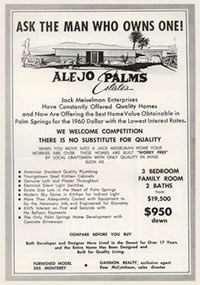
Unlike Alexander homes where the roofline varies from house to house borrowing from A-frame pitched style, flat, and
butterfly, the Meiselman homes are more sharply angular and primarily make use of Butterfly rooflines.
The site, location, and placement of the Meiselman properties is also unique from Alexanders. While the Alexander family of
builders bought large plots of land to develop and built dozens (even hundreds) of similar homes in specific neighborhood
tracts, Meiselman midcentury modern homes were built on scattered sites, one or two at a time, diffused throughout different
neighborhoods of central and north Palm Springs, Ca.
In the 1950's and 1960's, about 2,500 homes were built by the Alexander Construction Company. Meiselman built fewer than 200 houses, making Meiselman midcentury modern homes much more rare than Alexanders.
The “Wexler’s” are the most innovative homes and are designated as Palm Springs Class One Historic Sites. These Wexler
homes epitomize the exuberance and optimism of the mid-century modern era.
They also showed their functionality of implementation, whereas every component of the entire home could be placed within its
central core (kitchen, dual bathrooms) and literally shipped anywhere in the world. The unfortunate downfall of the Wexler
homes was that the structural components were constructed entirely of steel. A sharp increase in the cost of steel shortly
after construction of the seven homes made it unprofitable to build additional units.
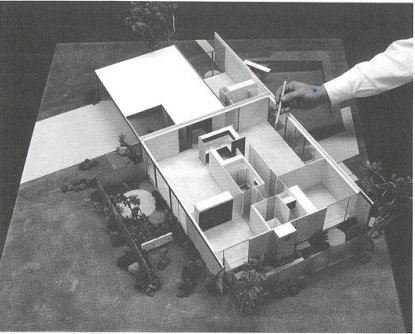
In 1962, the architects Donald Wexler and Ric Harrison introduced a novel all-steel system for the prefabrication of
affordable houses suitable for the desert. The project was sponsored by US Steel, the structural engineer was Bernard Perlin
of CalCor, and the builder was the Alexander Construction Company. The steel house tract was located in a remote windy part
of Palm Springs, north of the newly built Riviera Hotel—surrounded on 3 sides by empty desert.
The houses were primarily composed of steel and glass—a unique combination of off-site and on-site assembly. Part of the genius of their approach was taking components that had been designed for the rapid construction of school classrooms and adapting them into stylish, custom-appearing houses for the middle class.
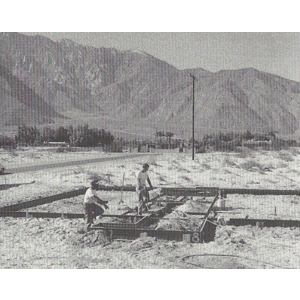
The wall modules consisted of an outer layer of light-gauge galvanized steel, a hollow core with gypsum board and fiberglass insulation, and drywall. The 9-by-36-foot central core of the house included the kitchen, two bathrooms, a laundry room, central hallway, and mechanical runs (electrical, ductwork, etc). Theses components were prefabricated in Los Angeles, trucked to the site, and lowered onto the slab by a crane. The outer rooms were then assembled around the core using the prefabricated steel panels, which were fit into a track template in the slab, interlocked, and bolted. The roof, also light-gauge steel, was then overlaid and bolted, supported both by the central core and the outer load-bearing steel panels. Each major room featured 8-foot-high sliding and stationary glass panels. Outer structural assembly took 3 days. The steel houses were impervious to heat, warping, rotting, swelling, termites, earthquake, and fire, and were very low maintenance.
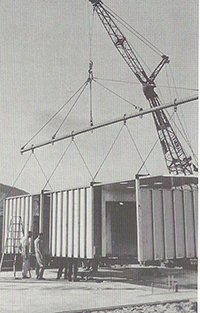
The first three of the seven houses (the models) were started in late 1961 and opened to the public in March of 1962, priced
between $13,000 and $17,000. The models were furnished by noted designer Arthur Elrod. The planned tract of 38 all-steel
houses were never completed due to the fact that shortly after the seven were built, the price of steel increased, decreasing
the profit margin of the builder, who then cancelled the project. During the 1970s and 80s the houses were largely forgotten
and fell into disrepair. Ultimately, the houses were rediscovered in the early 1990s and today—50 years later—six of the
seven houses have been restored to their original appearance.
In 2001, the city of Palm Springs granted the seven steel houses Class 1 Historic Site status. In 2012, the US Department of the Interior listed Steel Development House No. 2 (3125 North Sunny View Drive) in the National Register of Historic Places, making it the first midcentury structure in Palm Springs to be so designated.
On the tract designated for the steel homes, the Alexanders built the first phase of their newly redesigned “All Seasons”
homes, designed by the prestigious architecture firm of L.C. Major and Associates. These homes with their 1,456 square foot
spacious interiors, open floor plans, and improved insulation, were now intended for year round living. The outside
structures of these homes with their low hip roofline and angled beams have a distinctive Polynesian flair that was widely
popular due to increasing interest in Hawaiian travel.
The Alexander ranch homes located in the northwest section of the Racquet Club Estates have a unique history. The Alexander Construction Company built numerous tracts of the popular post
and beam modern homes in neighborhoods throughout Palm Springs but by 1963 the sales of these homes had declined.
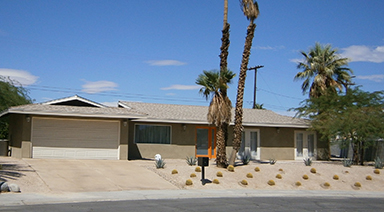
There was much hope for the new steel homes tract developed by Wexler and Harrison to play a major role in the next chapter
of the Alexander Construction Company. After only building 7 of the planned 38 homes adjacent to the Racquet Club Road
Estates the cost of steel significantly increased and a change in plans was needed. George and Bob Alexander had 31 home
sites to build on to finish this tract and had three other sites in Central and South Palm Springs in their queue.

Between 1963 and 1965 The Alexanders went on to build 200 of these ranch homes in five locations throughout Palm Springs. New
Riviera Gardens, Farrell
Canyon Estates, Golf Club
Estates, Sunrise Estates
and Araby Estates.
The homes in the new Riviera Gardens started an important chapter in the legacy of the Alexander’s and many of us our proud to call these well built houses home.
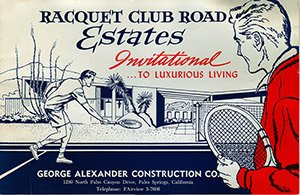
Keep up to date with whats happening in the neighborhood